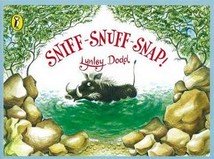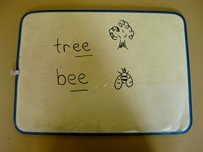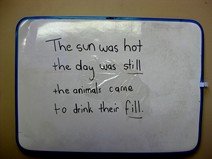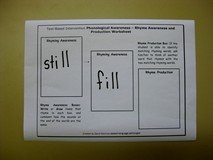Phonological Awareness Therapy
Text-Based Language Intervention for Young Children
 Phonological Awareness Therapy: This webpage provides you with an example of a
typical language intervention
session with a 5 year old boy with language difficulty.
Phonological Awareness Therapy: This webpage provides you with an example of a
typical language intervention
session with a 5 year old boy with language difficulty.
The language domain the clinician
has targeted for this session is phonological awareness.
Phonological awareness skills are a critically important part of early reading, and is considered a reliable predictor of a student's decoding and reading comprehension ability.
The rationale for these language therapy webpages is to demonstrate real, authentic language
intervention techniques and provide you with strategies and examples of high efficacy language therapy.
The goal is for you - whether you be a speech-language pathologist, teacher or parent - to have confidence to try this type of language intervention on your own students.
The language intervention method chosen is based on communicative reading strategies (Norris, 1991), as outlined and explained in Kathryn DeKemel's book,
Intervention in Language Arts.
Kathryn DeKemel's book features several chapters devoted to
inference and its role in reading comprehension.
Another book worth reading about text-based
intervention is Geraldine Wallach's,
Language Intervention for School-Age Students.
Communicative Reading Strategies
Phonological Awareness Therapy cont...
To acquaint yourself with communicative reading strategies as a language intervention method I recommend you
access the
shared reading
page and associated links. This will give you a brief but thorough background and foundation in the theory of communicative reading strategies.
Also, if you're up for an extra bit of reading please access the
phonological awareness
and
phonological awareness activities
webpages to learn more about phonological awareness and its importance to reading and reading comprehension.
Language Intervention - Background Information
Phonological Awareness Therapy cont...
Background Information: Aaron (name and situation changed) is a 5 year old boy who is thought to have
poor phonological awareness skills and poor understanding of the sound to letter link. Aaron's class teacher was also concerned that Aaron had difficulty learning the alphabet and was making minimal progress in that area. Aaron did not attend preschool.
Aaron's phonological awareness skills were assessed with the
Sutherland Phonological Awareness Test - Revised,
(SPAT-R) Roslyn Neilson, 2003. Aaron's
alphabet knowledge was assessed informally by the clinician.
The results of the SPAT-R indicated that Aaron's phonological awareness skills were significantly below average. Aaron had difficulty with most test items, including blending and segmenting sounds. His syllable awareness was good but his ability to detect and produce rhyme was well below average.
Aaron's knowledge of the alphabet was also poor.
Narrative and Story Grammar Language Goals
Phonological Awareness Therapy cont...
Objective: Aaron will identify rhyming words from a children's storybook.
Learning Approach: Communicative reading strategies and language stimulation techniques and phonological awareness principles.
Materials: Storybooks, reference books, graphic organizers.
Rating System: Phonological Awareness Scoring Chart
Resource Download
 Therapy Goals Worksheet
Therapy Goals Worksheet
Right-click to download this PDF file here.
Book Selection
Phonological Awareness Therapy cont...
Selecting the right book for language intervention is an important process. It's critical that the book chosen for therapy is at the right level of complexity for the student. If the books's too
difficult to understand the child may flounder; if the book's too easy, the student will learn very little.
The Fry readability graph is a useful tool for selecting books, based on grade level. But, perhaps the most
important method of book selection is to have your student read to you from a book, from their grade level, and note the number of miscues.
For younger readers, particularly those who are not yet reading, selection of the book should be based on the
complexity of the text. Generally books that feature rhyme, short, grammatically simple sentences and
that repeat key phrases and words are a good place to start.
Authors that do this particularly well are Dr Seuss and Lynley Dodd, among others.
Selected Book
Phonological Awareness Therapy cont...
 Sniff-Snuff-Snap!
Sniff-Snuff-Snap!
Written and Illustrated by
Lynley Dodd, 1995.
Sniff-Snuff-Snap!
Author: Lynley Dodd
Published 1995, Keystone Picture Books
ISBN: 1 86374 243 3
Brief Story Synopsis
Phonological Awareness Therapy cont...
Sniff-Snuff-Snap is about a warthog who is very protective of his waterhole. He guards it against a
range of African animals, including baboons, zebras and elephants. Each time the warthog chases the animals
away from the waterhole, they always sneak back.
The water level continues to fall until eventually all that remains is thick, brown mud. The last panel
features the warthog standing in the mud looking quite forlorn.
But thick grey clouds are in the background,
and the first few drops of rain tell us that the waterhole will be filled full of fresh water again soon.
The story features rhyming text and a range of African animals. The numbers of animals increase
from two to three to four and so on up to the number eight. So the text can also be used to review counting skills.
The Story is Read Together
Phonological Awareness Therapy cont...
The session begins with both Aaron and the clinician reading the story together. Sniff-Snuff-Snap is
quite a short book and can be read quite quickly. The clinician
reviews the story and does some preparatory work on some of the rhyming words, such as still - fill
hot - spot, etc. The setting and the background of the story are also discussed (preparatory set)
Clinician: Wow! Poor warthog! All the animals drank all the water from the waterhole. All that was
left was thick brown mud. Did you know that this story took place in Africa?'
Clinician: 'Africa is a really big
place that has lots of wild animals. We saw some of them in this book. We saw baboons, zebras, leopards
and other animals.'
Introduction of the Concept of Rhyme
Phonological Awareness Therapy cont...
Clinician: 'What I like about this book is that a lot of the words rhyme. Do you know what rhyme means
or ever heard of rhyme Aaron?'
Aaron doesn't respond verbally, but shakes his head, no.
Clinician: 'Rhyme means two words that sound the same at the end of the word.'
The clinician writes the words bee and tree together with two rough drawings on a whiteboard
to illustrate this point.
 Clinician: 'Tree and bee both sound the same at the end of the word. So these two words rhyme.
Listen to the way I sound the words treeeee - beeeeeee.'
Clinician: 'Tree and bee both sound the same at the end of the word. So these two words rhyme.
Listen to the way I sound the words treeeee - beeeeeee.'
The clinician elongates the sound of the ee and draws a line under the double ee on both the written
versions of tree and bee.
Clinician: 'It's the ee at the end of the word that sounds the same. Tree and bee rhyme. Repeat the words after me Aaron.'
Both the clinician and Aaron say treeeee and beeeee together.
Clinician: 'Can you think of another word
that rhymes with tree and bee?'
Aaron shakes his head, but is listening and is engaged with the therapy.
Clinician: 'If I was to say tree, bee, I could also say key. Key rhymes with tree and bee. They all sound the
same at the end of the word.'
The clinician writes the word key on the whiteboard, directly beneath tree and see. Both Aaron and
the clinician repeat the words several times.
Clinician: 'Let's see if we can add another word that rhymes with tree and bee. Can you think of any new
words that rhyme with tree and bee Aaron?'
Aaron: 'Fly?'
Fly is semantically related to bee, but doesn't rhyme with the word. Aaron has not quite 'got' the concept. After all, it is more difficult
to produce correct rhyming words than it is to recognize them.
Clinician: 'Pretty close Aaron. What if I said these words, fly and tea. Which one sounds (the clinician touches his ear) like bee?
The clinician repeats the word combinations bee-fly and bee-tea several times to Aaron.
Aaron: (A light goes on) 'Bee-tea. Bee-tea the same.'
Clinician: 'Good job Aaron, you've got it.'
Language Intervention - Rhyming Words in Sniff-Snuff-Snap
Phonological Awareness Therapy cont...
Clinician: 'On the first page it says, "The sun was hot the day was still, the animals came
to drink their fill." So we know it's a really really hot day, and that it's still. Still means there's no
breeze blowing, so it's hot and sticky and no wind.'
Aaron: 'It's a yuck day.'
Clinician: 'Yes it is. The poor animals must be thirsty, so they must want to go to the waterhole. They need to drink their fill. To drink their fill means to drink until
their tummies are full of water. So they drink, drink, drink, because it's hot and still so
they need to drink their fill.'
Clinician: 'Now, we have two words that rhyme here Aaron, just like the other words we worked on. The two rhyming words in this book are different from the other rhyming words we worked on before'
Target Passage Is Written Onto the Whiteboard
Phonological Awareness Therapy cont...
The clinician writes the first sentence onto the whiteboard in large letters, 'The sun was hot,
the day was still, the animals came to drink their fill.' (Sniff-Snuff-Snap! by Lynley Dodd, 1995)
 The two target rhyming words are underlined. The clinician then reads the sentence to Aaron, tracing over each word with his finger. When the clinician reads the target words he emphasizes the words still and fill, by
pausing slightly and raising the pitch of his voice a little.
The two target rhyming words are underlined. The clinician then reads the sentence to Aaron, tracing over each word with his finger. When the clinician reads the target words he emphasizes the words still and fill, by
pausing slightly and raising the pitch of his voice a little.
Clinician: "The sun was hot...the day was st..." (cloze procedure)
Aaron: 'Still.'
Clinician: 'Good boy. "The animals came to drink their f..."(cloze procedure)
Aaron: 'Fill... Cause they thirsty.'
Clinician: 'So, Aaron, if we look at these two words...' (points to the words still and fill on the whiteboard) 'The words say still...fill.'
The clinician pauses.
Clinician: 'Do they sound the same?'
Aaron: 'Yes, they same. Still, fill.'
Clinician: 'Gee, great job Aaron. Yes they are the same. They do rhyme. They both sound the same at the end of the word,
don't they? Let's write that onto our worksheet here. What were the words again?'
Aaron: 'Still fill.'
Clinician fills in the Worksheet
Phonological Awareness Therapy cont...
Clinician: 'Ok, we'll write that down. If we look at both words they both have the letters i and l' Can you see how they look the same? They both say 'ill at the end.'
The clinician writes the words still and fill onto the two rhyming words boxes, on the worksheet.

The phonological awareness worksheets are a useful way to chart the words targeted for therapy.
The first two boxes on the worksheet are headed Rhyme Awareness. You can write the target word,
create a rough drawing, or both.
The example sheet demonstrates a written word example, plus accompanying picture. The final box, Rhyme Production, is for documenting any new rhyming words that are produced by the student.
Resource Download
 Phonological Awareness Worksheet
Phonological Awareness Worksheet
Right-click to download this PDF file here.
 Phonological Awareness Worksheet Example
Phonological Awareness Worksheet Example
Right-click to download this PDF file here.
Rhyme Production Box
Phonological Awareness Therapy cont...
The clinician reviews the target passage with Aaron. The passage is read in context with no particular emphasis
on the target rhyming words still and fill. The rationale for this is so that Aaron can hear the passage
again simply as a story, not as something parsed or dissected.
Once Aaron has had the target passage read to him again in full, the clinician gently prods Aaron to
think of another word that rhymes with still and fill.
Clinician: 'We have still and fill. Can you think of another word Aaron that rhymes with still and fill?
It doesn't have to be a real word. It can be a pretend word, just so long as it sounds the same at the end of the
word.'
Aaron: 'Um...ill?'
Clinician: 'That's excellent Aaron. Both words end in ill. That's true. Which of these two words has
ill at the end of the word?' (Clinician pauses briefly)'Pool - pill.'
(choice and contrast question)
Aaron: 'Pill.'
Clinician: 'Well done Aaron. You're right, it's pill. Let's both say them together, still, fill, pill.'
Summarization
Phonological Awareness Therapy cont...
Clinician: 'Well, Aaron, today we talked about rhyme and how some words sound the same at the end
of words. They're words that rhyme. We read Sniff-Snuff-Snap which has lots of rhyming words in it.'
Clinician: 'We talked about two of the rhyming words from that book, still and fill. We discovered that
both sound the same at the end of the word. Still and fill, rhyme.'
Clinician: 'We also came up with some other words that rhyme with still and fill, such as pill.'
Conclusion and Scoring Chart
Phonological Awareness Therapy cont...
Resource Download
 Phonological Awareness Scoring Chart
Phonological Awareness Scoring Chart
Right-click to download this PDF file here.
The phonological awareness session is a typical portrayal of text-based language intervention. The session was completed
in about 25 mins. Aaron worked through a lot of difficult material in that time and did very well, but his
attention was beginning to wane toward the end.
The clinician marked Aaron's rhyme awareness at the conclusion of the session as 1, which indicates
that Aaron has some understanding of rhyme but rhyme production was still difficult for him. Aaron still requires
quite significant work in all aspects of phonological awareness and print awareness.
Rhyme Awareness and Production - Next Session
Phonological Awareness Therapy cont...
The next session with Aaron will consist of these goals:
Goal 1: Revise rhyme awareness.
Goal 2: Review target passage that features still - fill.
Goal 3: Generate rhyme production.
Goal 4: Introduce new rhyme targets.
References
Collins Essential Dictionary and Thesaurus (2007) Harper Collins Publishers
DeKemel, K.P. (2003) Intervention in Language Arts: A Practical Guide for Speech-Language Pathologists. Butterworth-Heinemann.
Dodd, Lynley, (1995) Sniff Snuff Snap! Keystone Picture Books
Kaderavek, J & Justice, L.M. (2002) Shared Storybook Reading as an Intervention Context: Practices and Potential Pitfalls. American Journal of Speech-Language Pathology, Vol 11. 395-406.
Norris, J.A. (1991) From Frog to Prince: Using Written Language as a Context for Language Learning, Topics in Language Disorders. Vol 12, 66-81
Paul, R. (2001) Language Disoders form Infancy through Adolescence. Assessment and Intervention. Mosby
Schuele, M.C. & Boudreau, D. (2008) Phonological Awareness Intervention: Beyond the Basics. Language, Speech, and Hearing Services in Schools. Vol 39. 3-20.
Scott, C.M. (2009) A Case for the Sentence in Reading Comprehension. Language, Speech and Hearing Services in Schools. Vol 40. 184-191.
Wallach, G.P. (2008) Language Intervention for School-Age Students: Setting Goals for Academic Success. Mosby Elsevier
Wagner, R.K. Muse, A.E. & Tannenbaum, K.R. (2007) Vocabulary Acquisition: Implications for Reading Comprehension. The Guilford Press
Content Last Modified 7/11
Return from Phonological Awareness Therapy to Language Therapy
Enjoy this page? Please pay it forward. Here's how...
Would you prefer to share this page with others by linking to it?
- Click on the HTML link code below.
- Copy and paste it, adding a note of your own, into your blog, a Web page, forums, a blog comment,
your Facebook account, or anywhere that someone would find this page valuable.



 Phonological Awareness Therapy: This webpage provides you with an example of a
typical language intervention
session with a 5 year old boy with language difficulty.
Phonological Awareness Therapy: This webpage provides you with an example of a
typical language intervention
session with a 5 year old boy with language difficulty. 
 Clinician: 'Tree and bee both sound the same at the end of the word. So these two words rhyme.
Listen to the way I sound the words treeeee - beeeeeee.'
Clinician: 'Tree and bee both sound the same at the end of the word. So these two words rhyme.
Listen to the way I sound the words treeeee - beeeeeee.'
 The two target rhyming words are underlined. The clinician then reads the sentence to Aaron, tracing over each word with his finger. When the clinician reads the target words he emphasizes the words still and fill, by
pausing slightly and raising the pitch of his voice a little.
The two target rhyming words are underlined. The clinician then reads the sentence to Aaron, tracing over each word with his finger. When the clinician reads the target words he emphasizes the words still and fill, by
pausing slightly and raising the pitch of his voice a little.

